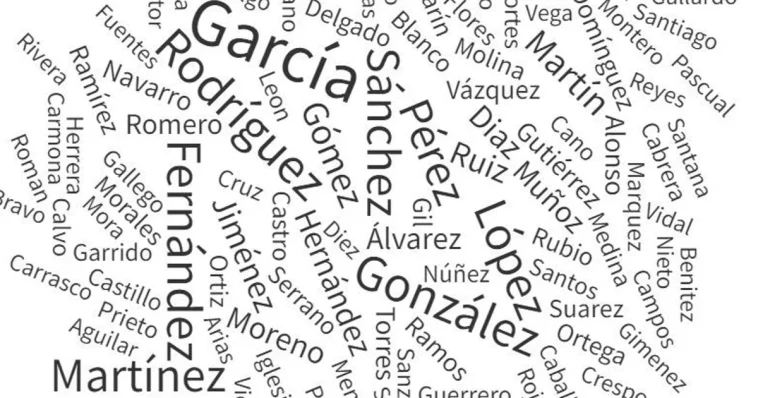In most Spanish-speaking countries, people are traditionally identified by two last names. The usual format is: First name + father’s last name + mother’s last name. For example, someone named María González López is María, daughter of Mr. González and Mrs. López. In daily life she may be called simply María González, but in legal documents, diplomas, or government papers, both surnames are always used.
This practice goes back to the centuries of Spanish history when families wanted to make sure that both sides of the family were represented. It was a way of saying: this person belongs to two families, not just one. In a society where family identity was very important, it became a tradition that survived until today.
Another very practical reason is that many Spanish surnames are extremely common. Names like García, González, Rodríguez, López, Pérez, Sánchez can be found by the millions in Spain and across Latin America. If people carried only one surname, there would be endless confusion. Imagine a classroom in Mexico City with five students named Juan García. With the double surname, you might have Juan García López, Juan García Torres, or Juan García Ramírez. Instantly, everyone knows which is which. The system brings clarity and helps avoid mistakes in public records, education, and even daily life.
In Italian culture things developed differently. Italian last names are often very varied and localized, sometimes unique to a single family or village. Small spelling changes create new names: Russo, Ruzzo, Rosso or DeMarco, DiMarco, DeMarcos. Because of this variety, a single surname is usually enough to identify a family line, and Italians never developed the habit of using two. If Spanish surnames had the same level of variation, maybe the double surname system would never have been necessary.
Another interesting case is Argentina. Many Argentinians have Italian surnames, due to the massive immigration from Italy in the 19th and 20th centuries. In everyday life, Argentinians often introduce themselves with just one last name, especially in social or professional settings. It sounds more natural in Argentine culture to say Carlos Bianchi or Mariana Rossi instead of using both surnames. However, in official documents like passports, national IDs, or legal contracts, the traditional two surnames are still required. In contrast, in Mexico, Colombia, or Spain, people usually mention both surnames more often, not only on paper but also in formal introductions.
It is also worth noting that Spanish is not the only language with this tradition. Portuguese and Brazilian names often use two surnames as well, but the order can vary, the maternal last name goes first, and sometimes even more than two surnames appear. A Brazilian might carry four last names, combining several generations. In practice, Brazilians will shorten their names in daily life, using just one or two surnames depending on the situation.
The double surname system is more than a technical detail of grammar — it reflects cultural values of family, heritage, and identity. When you meet someone named José Martínez Gómez, you are not just learning his name, but also a small piece of his family story: the father’s side (Martínez) and the mother’s side (Gómez).
In some Spanish-speaking countries, parents are allowed to reverse the order of last names—put the mother’s surname before the father’s. For example, in Spain, since a 1999 law update, parents can choose the order at their child’s registration, and that order must be the same for all children. In Peru, the Constitutional Court ruled it’s up to the parents to choose the order; the father’s surname is not automatically first. And in Brazil, it’s already common practice to list the mother’s surname before the father’s—there is no fixed rule and parents decide what order to use.
Puerto Rico is a special case. Because it is part of the United States but also deeply Hispanic, Puerto Ricans traditionally use two last names, just like in the rest of Latin America. But in practice, U.S. forms and systems often accept only one surname, which has caused many Puerto Ricans to “drop” the maternal surname or merge both into a single field. This creates interesting identity issues: legally and culturally they keep both names
So the next time you notice two last names on a Spanish passport, diploma, or business card, remember that it’s not an extra complication. It is a way of honoring both parents, preserving clarity in societies where surnames repeat endlessly, and keeping alive a cultural tradition that has been part of the Spanish-speaking world for centuries.
Si quires leer más en español
You can explore more about this tradition through these Spanish-language resources:
Wikipedia’s article on el apellido explains the double surname practice and its legal roots in Spain Wikipedia
Why Spain uses two surnames – a clear explanation from AS newspaper, covering how the system became law in the 19th century Diario AS
A genealogical article that also describes how civil registries formalized the two-surname system for identification Genealogía Hispana
No es Perú ni Bolivia: Brasil usa primero el apellido materno por tradición en sus documentos Infobae.




